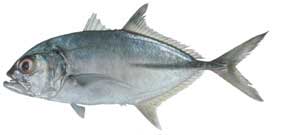
Caranx sexfasciatus
Turrum, Great Trevally
The Bigeye Trevally is silvery to dusky or dark on its body, especially along the back. There is a dark spot on the gill cover, but none on the pectoral fins. Juveniles are golden yellow and have 4-7 broad, dark vertical bars on the body. The breast is completely scaled. The body is not very deep with the head curving to a slightly pointed snout. The eyes are relatively large. The lateral fin is strongly curved. The straight portion consists of 28-37 scutes. The first dorsal fin has 8 spines. The second has 1 spine and 19-22 soft rays and the anal fin has 3 spins and 15-17 soft rays.
The Bigeye Trevally feeds mostly at night, especially very dark nights. They feed mostly on eels and crustaceans, blennies, damselfish and other fish.
Bigeye Trevally are broadly found in tropical waters throughout the Indian and Pacific Oceans from east Africa to western America.
Bigeye Trevally are found in rocky areas near shore as well as at outside reef drop-offs on the edge of deep tide-running channels, and in deeper waters beyond the reef.
This Trevally can reach over 2 feet in length and weigh an average of 9 pounds.
31 pounds, 8 ounces (IGFA)